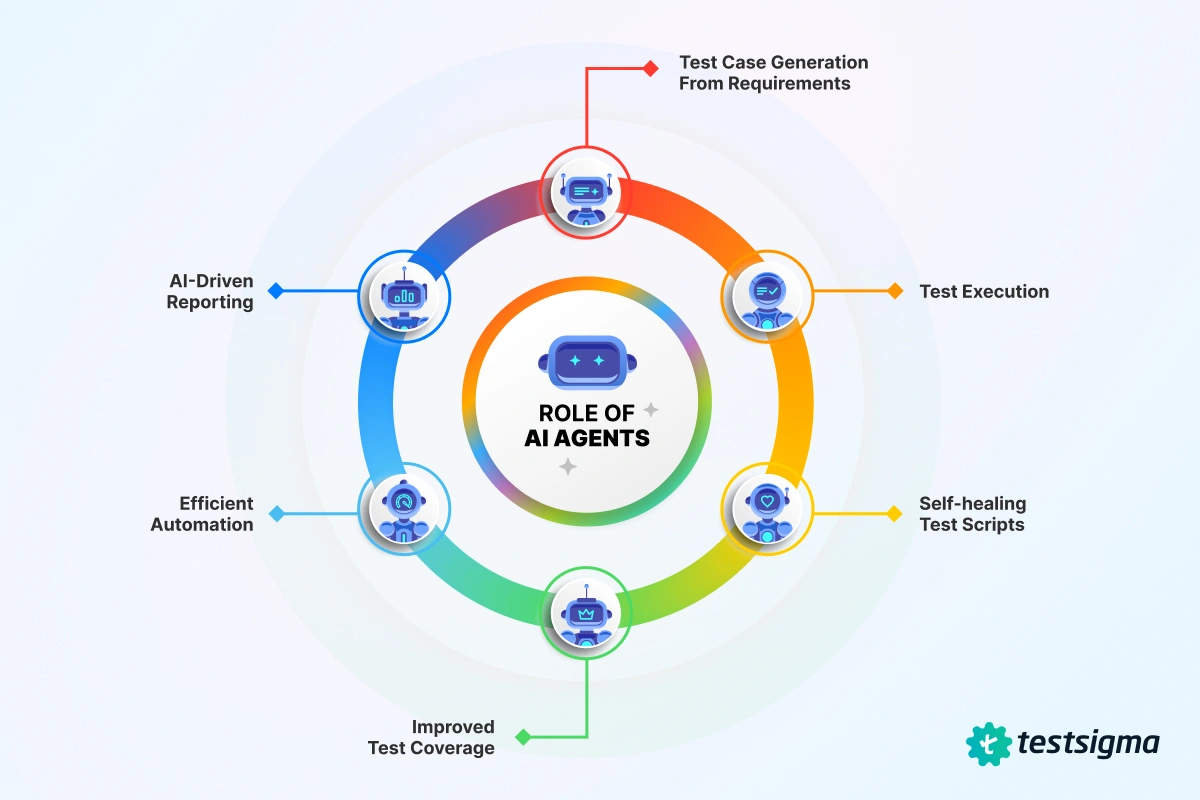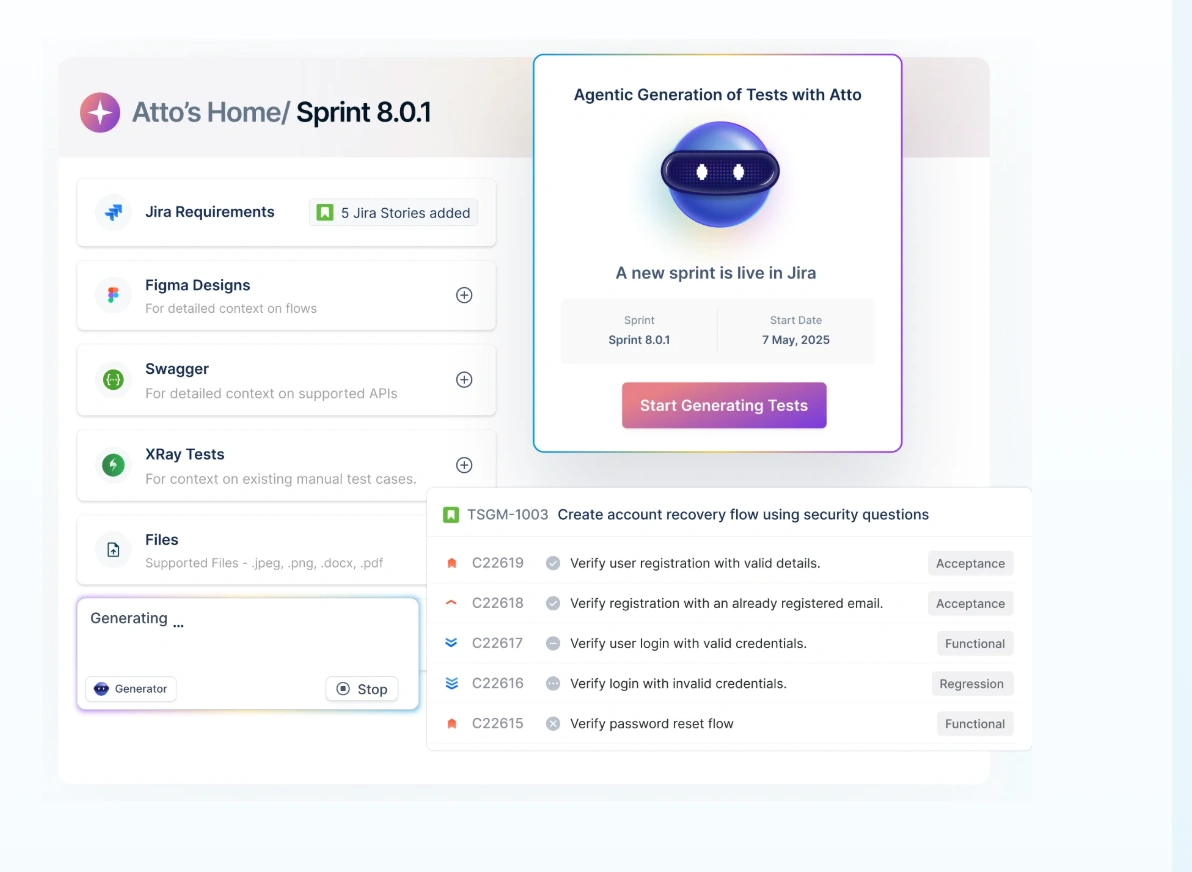Since its inception, agentic AI testing has been pathbreaking. It offers numerous benefits and shifts the path to advanced testing. Agentic AI in testing has been a game-changer, revolutionizing traditional testing methods and accelerating the shift toward intelligent, autonomous QA practices. Let us see how Agentic AI for testing can accelerate your QA game.
Table Of Contents
- 1 What Is Agentic AI Testing?
- 2 How Does Agentic AI in Testing Work?
- 3 What Are The Key Aspects Of Agentic AI In Testing?
- 4 Benefits Of Using Agentic AI In Testing
- 5 Why Businesses Need To Adopt Agentic AI?
- 6 What Are Best Practices For Implementing Agentic AI Testing?
- 7 How Testsigma Can Help You With Agentic AI Testing
- 8 Frequently Asked Questions
What is Agentic AI Testing?
Agentic AI testing is an advanced form of AI testing powered by autonomous agents. These agents are nothing but an intelligent AI model with a rigid entity. They help plan, organize, and execute tests independently. They act as AI coworkers/assistants for QAs and work with minimal human intervention.
How Does Agentic AI in Testing Work?
Agentic AI in software testing operates through autonomous, intelligent AI agents that function similarly to abstract sensors, constantly perceiving, interpreting, and acting within their environment. In this case, the environment is the Application Under Test (AUT) and the broader test execution ecosystem, including code repositories, CI/CD pipelines, logs, and test reports.

Agentic AI agents in software testing are equipped with perception capabilities such as analyzing UI elements, APIs, or test data, allowing them to understand the structure and behavior of the AUT in real time. They continuously monitor the application’s state, recognize changes like UI shifts or API schema updates, and adapt the testing strategy dynamically.
What Are the Key Aspects of Agentic AI in Testing?
Agentic AI for testing revolves around some key aspects like
- Autonomous Testing Agents – AI agents operate without human intervention. Based on goals and inputs, they decide what, when, and how to test. Think of them as task-specific workers, e.g., test generation, execution, analysis with built-in intelligence.
- Context Awareness – Agents understand the Application Under Test (AUT) by analyzing UI structure like DOM, XML, visual layout, API responses, product documentation, and test artifacts. They perceive environment changes like new UI components or updated flows and adapt test plans accordingly.
- Goal-Driven Decision Making – Agents are guided by testing objectives to maximize coverage, minimize test execution time, and reduce flaky tests. They apply reasoning algorithms or heuristics to prioritize actions aligned with these goals.
- Continuous Learning – Agentic systems incorporate feedback loops using historical test results, failure patterns and code changes. They improve test accuracy and relevance over time through machine learning or reinforcement learning.
- Real-Time Decision Making – The RAG(Retrieval Augmented Generation) element in AI architecture helps with real-time decision making.
Benefits of Using Agentic AI in Testing
Some benefits of using Agentic and Generative AI in software testing are as follows:
- Autonomous Test Execution – AI Agents can assist QAs as a coworker;as they independently create, run, and adapt tests based on system changes and human inputs.
- Faster Test Creation and Maintenance – AI testing tools like Testsigma can automatically generate test cases from requirements, user flows, or UI changes, drastically reducing manual test scripting time.
- Self-Healing Capabilities – When a test breaks due to UI/API changes, the agent detects and fixes the locator or logic, preventing flaky test failures and reducing test maintenance overhead.
- Scalable And Parallel Execution – Multiple agents can work simultaneously to test different features, devices, or platforms in parallel boosting test coverage and speed.
- Intelligent Test Coverage – Agentic systems prioritize test cases based on risk, recent code changes, user behavior, or business criticality, ensuring smarter regression testing.
- Better Test Insights & Reporting – Agents not only test but also analyze failures, generate summaries, and trace bugs to specific commits or modules, improving debugging efficiency.
Why Businesses Need to Adopt Agentic AI?
The AI agents market was valued at $3.7 billion in 2023 and is projected to reach $103.6 billion by 2032, with a CAGR of 44.9%. This explosive growth underscores a massive shift toward autonomous, decision-making AI systems across industries. In an AI-first world, agentic AI represents a transformational opportunity for software testing as,
- As modern applications grow in complexity and release cycles accelerate, traditional testing methods fail to deliver speed, scale, and precision. So agents with self-healing capabilities can help in this scenario.
- Agentic AI test automation empowers teams with self-directed test agents that autonomously plan, execute, and adapt test strategies, drastically reducing manual effort and increasing test resilience.
- Businesses that adopt agentic AI early in QA stand to gain faster time-to-market, lower maintenance costs, and smarter quality coverage, creating a significant competitive edge.
What Are Best Practices for Implementing Agentic AI Testing?
- Start With Clear Testing Goals – Define the specific outcomes you expect, such as faster regression cycles, improved test stability, or better defect detection. Clear goals will guide how you configure agents and measure their effectiveness.
- Choose the Right Testing Tool – Select an ideal tool that supports AI-driven test automation with agentic AI capabilities like autonomous test generation, execution, and analysis. Ensure it integrates well with your existing tools, CI/CD pipelines, and development workflows.
- Feed Agents With High-Quality Contextual Data – The more context agents have, the better their decisions. Provide access to requirements, user journeys, historical bugs, and application state data to make testing more relevant and intelligent.
- Monitor and Fine-Tune Agent Behavior – Continuously observe how AI agents perform, which tests they prioritize, how they adapt to changes, and what failures they report. Use this insight to refine agent parameters and improve learning models.
- Adopt an Incremental Rollout – Begin with a controlled scope, such as smoke tests or a single application module. Gradually expand the coverage and autonomy of agents based on performance benchmarks and user feedback.
- Stay Updated On Agentic AI Evolution – The agentic AI landscape is evolving rapidly with advancements in multi-agent systems, LLMs, and self-adaptive workflows. Stay informed and periodically evaluate new capabilities to maintain a competitive edge.
How Testsigma Can Help You with Agentic AI Testing
Testsigma is a codeless Agentic AI-powered test automation platform with advanced Agentic capabilities. It allows testers to automate web, mobile, API, SAP, Salesforce, ERP, and desktop app testing without requiring any coding expertise.
Testsigma offers advanced testing with its intelligent AI agent, Atto, the AI coworker for QAs. Atto is a powerful agent that mobilizes a crew of AI agents that work with QA teams in every phase of the testing process.
- Sprint Planner Agent – Automatically plans your tests once a Jira sprint starts by detecting the new sprint.

- Generator Agent – Automatically generates test cases from natural language, no coding required. Accepts input from prompts, Figma designs, JIRA requirements, videos, documents, images, and more.
- Optimizer Agent – Continuously refines your test suite to keep it lean, stable, and high-impact, removing redundancy and ensuring only the most relevant tests run.
- Runner Agent – Validates the generated tests and enables in-browser execution, making it ideal for quick sanity checks and low-effort test runs.
- Analyzer Agent – Provides comprehensive assets for issues related to code changes for accelerated release cycles.
- Bug Reporter Agent – Captures detailed logs, screenshots, and step-by-step actions for every failed test, making it easy to share with developers and accelerate debugging.
Benefits of Using Testsigma
- Parallel testing – Run multiple test cases simultaneously across devices and browsers to significantly reduce execution time and speed up your feedback loop.
- Extensive Device Lab – Access a cloud-based lab with 3000+ real and virtual devices for testing on different iOS and Android versions, screen sizes, and manufacturers without managing hardware.
- Cross-Browser Compatibility – Ensure your web apps work seamlessly across all major browsers, including Safari, Chrome, Firefox, and Edge, using real environments in the cloud.
- Reduced Flakiness – AI-driven self-healing tests and smart wait strategies automatically fix broken steps and adapt to UI changes, dramatically minimizing flaky test failures.
- Enhanced Test Coverage – Get comprehensive coverage for your AUT with advanced AI suggestions.
- Self-Healing Capabilities – Avoid the hassle of manually modifying the changes made to your application. Testsigma can detect changes in your application and update them automatically.
Frequently Asked Questions
AI testing is evolving from just automation to intelligent quality engineering, where decisions are made by self-learning agents that optimize testing continuously. Businesses that invest early in AI-first QA strategies will enjoy faster releases, better quality, and lower costs in the long run.
Generative AI creates new content like text, images, or code based on input prompts whereas Agentic AI takes goal-directed actions in a given environment, making decisions, learning from feedback, and adapting over time e.g., AI agents that execute and maintain tests autonomously.
An example of Agentic AI Testing is Testsigma’s Atto. Atto performs Agentic Testing with its specialized agents. Tasks like test case creation, planning, organizing, executing and even bug reporting can be tracked with these agents.




